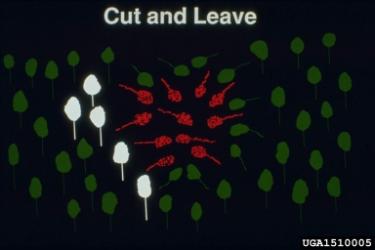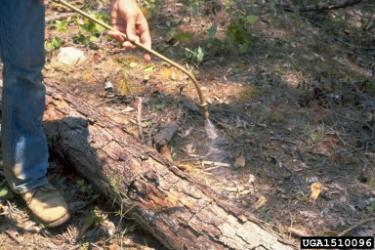When You Have an Outbreak
If you’ve confirmed you have an active southern pine beetle outbreak, you have a few different options for fighting back.
Cut & remove
This is your most effective option. Identify the most recently infested trees, where the pitch tubes are fresh and the crown is still green or just beginning to fade. Then cut and remove these, along with a buffer strip of healthy trees. Your buffer should be at least as wide as the height of your trees.
- Advantages: This method removes the beetle population from the site and clears the site for regeneration. Plus, healthy trees from the buffer zone can be salvaged and harvested to provide you with revenue.
- Disadvantages: This method requires harvest equipment, which can have limited access in remote or rough terrain. You must get theharvesting done quickly as well, and you will need a buyer for any salvaged wood.The "cut & leave" management option for souther pine beetle infestation.
Cut & leave
Identify infested and buffer trees, fell them toward the center of the infestation, and then leave them on the ground. Beetles look for “vertical” trees, so downed trees can disorient them and stop their spread.
- Advantages: This method can be used when salvage isn’t feasible or if the site is too hard to access with harvest equipment. It’s also inexpensive and fast.
- Disadvantages: This method doesn’t remove the beetles from the site, so you’ll need to frequently check the area for new outbreaks. The felled trees also provide no revenue.
Cut, pile & burn
Identify infested and buffer trees, fell them and then burn them, making sure the bark is thoroughly charred.
- Advantages: When done carefully and properly, this method is effective and compatible with restoration and regeneration efforts later on.
- Disadvantages: You don’t want to start a wildfire or create an erosion hazard, so this method must be done only when the conditions are right. You must also secure any required local burn permits and comply with all burn regulations.A professional sprays insecticide on a cut log to combat an infestation.
Cut & spray
Identify infested trees, cut them into workable lengths and then douse them with appropriate insecticides and fungicides. The current lack of effective on-the-market insecticides for this use makes this your least desirable option. Some tree injection systems have shown promise, but you will need help from your local extension agent or forester to secure something that works.
The best option is to prevent an infestation. Good forest management can keep your woodlands productive, healthy and SPB-free for generations to come.
How can I get more tips?
It’s simple! Enter your email below.


